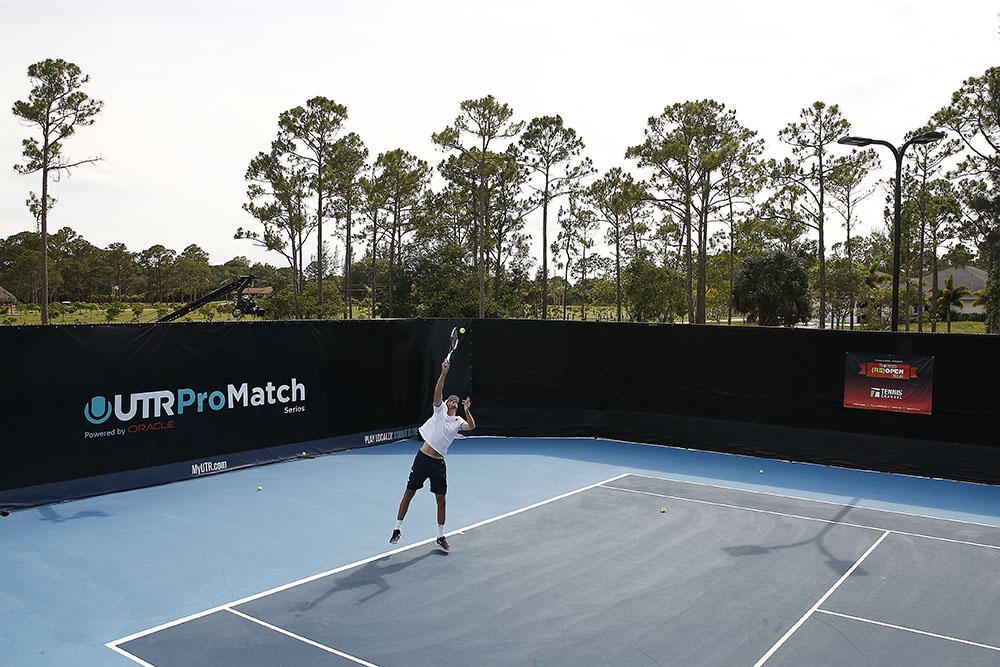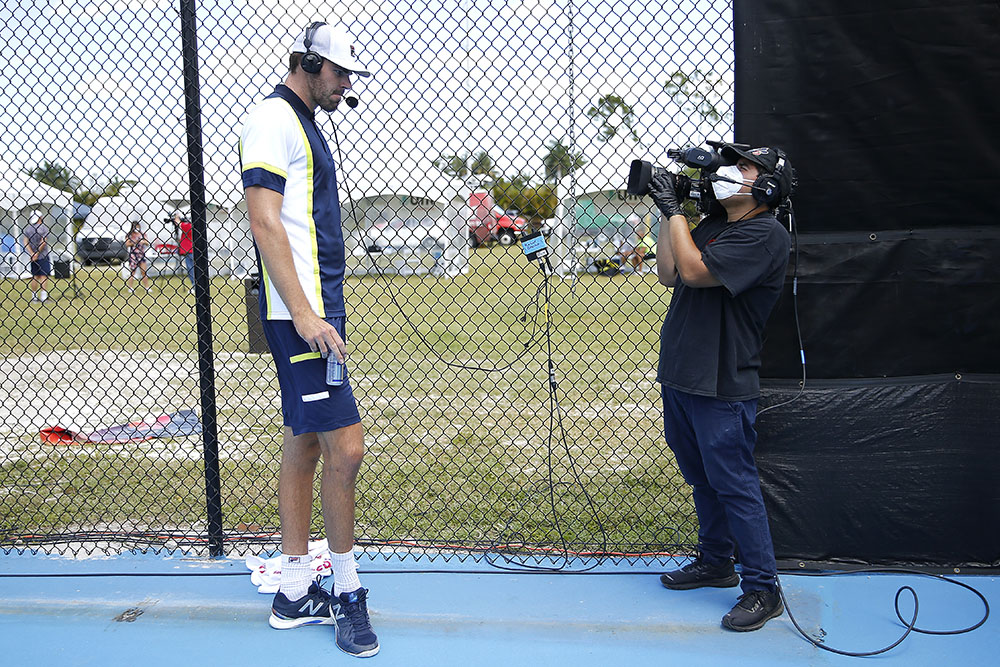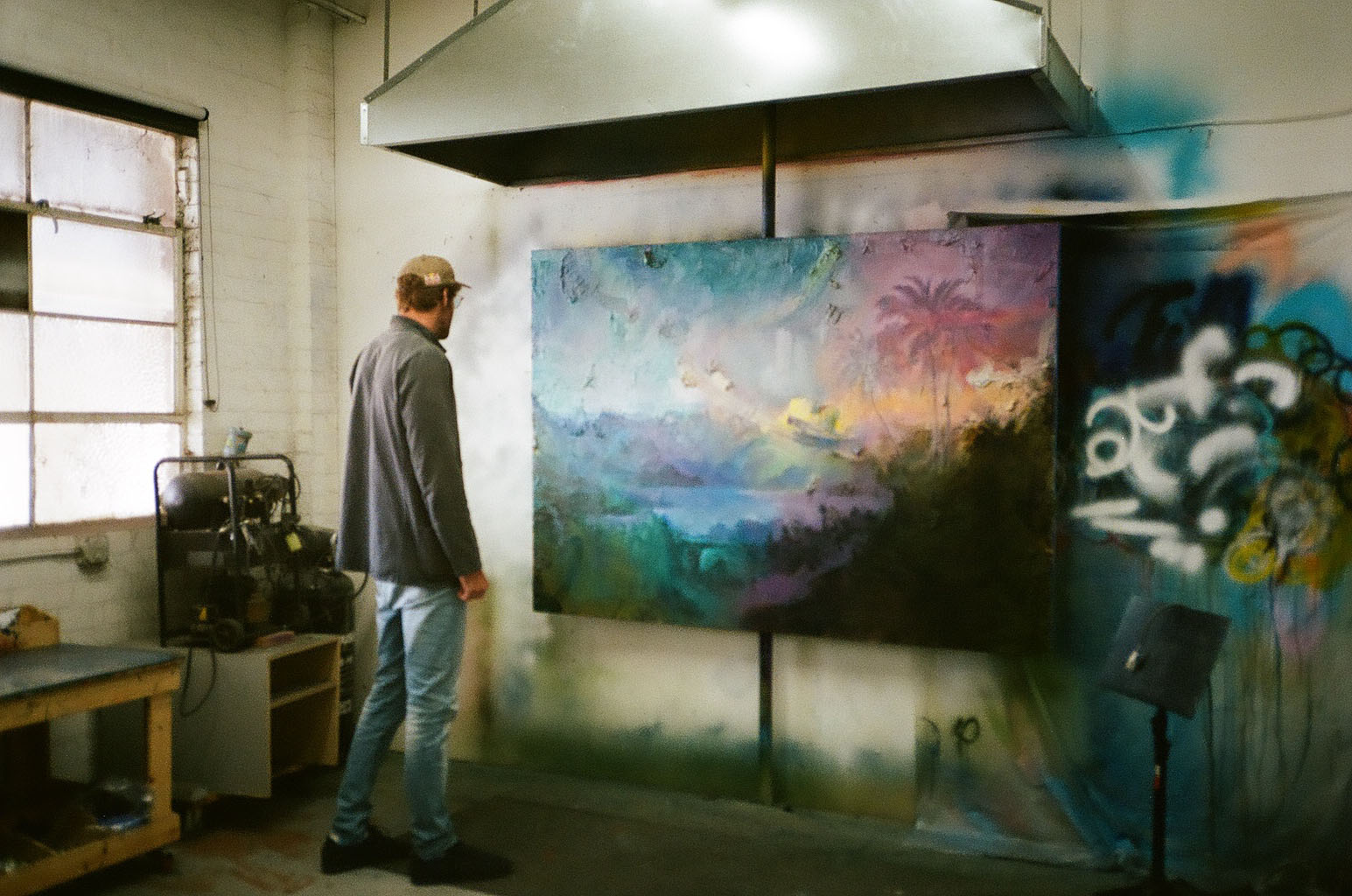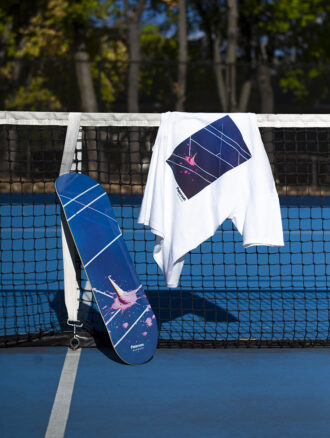By Giri Nathan
Tennis is back—kind of. Sure, it was on a private court in West Palm Beach, Fla., and there were only four players, and it was a shorter format, and cleaning was so rigorous that the net was wiped down before and after play. Also, there were no fans, no ATP points, and no handshakes (racquet bumps instead). But the UTR Pro Match event offered the closest approximation of high-level play in months. In a field of good young players ranked between No. 29 and 57, big-serving Reilly Opelka came out on top, dispatching Miomir Kecmanovic in the final. We called up the champion to find out how he feels about tennis in quarantine, what he thinks the ATP gets wrong with gambling and sponsors, and what it’s like returning serve while seven feet tall.
Giri Nathan: Congrats on winning over the weekend. What was it like playing in that format?
Reilly Opelka: That was my first time playing Fast Four and whatnot, but it was just nice to be back out there.
GN: Was there something eerie or different about it: no ball people, no fans, just you guys and the chair ump?
RO: Oh, it wasn’t as weird as it looked. Once I watched it from home, it looked a lot more eerie than it actually was. Just because we practice with each other like that all the time. So I guess if there was a bigger match on the line, or we were playing for a lot more money, then maybe it would be different. But I took it like just a normal day of practice, where I was a little more competitive than normal.

GN: What’s your relationship to tennis been like during this time? Are you playing regularly?
RO: Yeah, I have, but it’s kind of getting annoying now, since we don’t have a start date. My two goals that come out of this are, I want to make sure I’m stronger, and I’m healthy. If I’m not fitter or stronger and I’m banged up by the time the season comes back, that’ll be a pretty big fail on my end and on my team’s end. And also just trying not to burn out, either. So I feel like I’ve maybe played a little much, which is probably a lot different than what other people are saying. So I think I’m gonna kind of ease off for the next couple of weeks. Enjoy some time off and then maybe pick back up again.
GN: On a related note, how are the milkshakes at Wawa these days?
RO: They’re unreal, man. The Oreo milkshakes are…I didn’t realize how good they were there. There’s a Wawa two or three miles from my house. So everything else was closed, that was the only thing open, and they’re open 24 hours, so…I really didn’t know that their milkshakes were that good.
GN: The sandwich station is also on point.
RO: Sandwich station’s great. Yeah, Wawa’s impressive. I’m actually heading there right now.
GN: Nice. On a somewhat more serious note, how do you think the ATP has handled this crisis, and what would you like them to have done differently?
RO: The ATP? I think they couldn’t have handled it much worse. We’re completely left in the dark, we don’t know what’s going on. And the execs haven’t taken pay cuts. You know, the WTA execs are taking pay cuts, the WTA have gotten first-round prize money at Indian Wells. I rented a really expensive house for two weeks there. Way in the red there. I don’t think it’s a good look when the ATP execs are gonna be making more money than Roger Federer’s prize money this year. And again, I don’t know what the reasoning is. We’ve been left in the dark completely as players so we don’t even know what they’re really doing right now.
GN: And while it is nice that some of the players have been trying to organize a relief fund for other players, maybe this is not something that should fall to the players to have to do in the first place.
RO: One hundred percent. Players should never pay other players. But given the mess that we’re in, it seems necessary, it seems like it’s their only hope. So I somewhat support the Player Relief Fund. I think there’s plenty of guys I know that are 115 in the world that are paying for a coach and physio, trying to do things the right way, extremely professional, that are hurting the most, actually. I don’t think paying a guy 650 in the world or 700 in the world, giving them a $10,000 check—I mean this in no disrespectful way at all, but guys ranked below 500 are saving money in this time period. They’re actually saving money by not traveling and playing. I think protecting the guys from 100 to 400 should be the number-one priority. I don’t think, as an ATP exec, you should be supportive of asking your players to pay for other players when you haven’t even taken a pay cut yourself, when us players have taken a 100% pay cut. That’s completely wrong. It’s actually shocking that it hasn’t been addressed more. The PGA execs took pay cuts right away, the WTA, the ITF, the USTA.

GN: A crisis like this can expose things that weren’t even working that well during normal times. What do you think are some long-term lessons that tennis can take away from this strange moment?
RO: There’s a few. Our TV rights are completely messed up. Another thing is players have no freedom. The ATP fines me whenever I drink a Red Bull on the court. I’ve always drank Red Bull on court. They fine me for everything. Your logos can only be so big, and whatnot. And their argument is “Oh, it’s a gentleman’s sport,” but look at the PGA. Golf is way more of a gentleman’s sport than tennis will ever be, and those guys look like NASCAR drivers now. My coach Jay Berger’s son is Daniel Berger, a top golfer. They all love the organization, they actually love their execs, and they really feel they’re on their side. And I’m like, man, I definitely know we can’t say the same as tennis players. I would let players have unlimited branding. If someone wants to put a logo on you, whatever, so be it. That’s perfect.
And then another thing: Look at the gambling in golf. It’s gonna happen anyway in tennis; if you sign a TV rights deal—some of these gambling firms that make so much money off of tennis want to sponsor tournaments, and they want to have events. The gambling is going to happen regardless, and the only difference would be for players to benefit from it. Have more tournaments, have more prize money, and earn from it. I’m sure after this crisis, it’s gonna be even tougher to have those small 250 events, and it’s just these little things that can make the difference.
GN: To go back to on-court stuff, you’ve been talking about returning really well lately. That’s always a huge skill for a seven-footer. Where’s that coming from? Anything in particular you’ve been training or watching or working on?
RO: Everything. I’ve been watching a lot, I’ve been training, I’ve been working on it a lot. We’ve been doing so many different drills specifically for it. The numbers don’t really lie. Even when I was losing the first couple matches at the beginning of the year, with [Fabio] Fognini and [Pablo] Cuevas, I was still returning better. And then I really started piecing things together in the New York Open and especially in Delray. And then even at Davis Cup and the UTR event I returned great. I didn’t play many breakers. I was in a lot of return games. So if I can be breaking serve at around 15% and still holding serve above 90% of the time, those are the two numbers where I can compete for a huge title.
GN: So is there a particular drill that you’ve been working on that has been most helpful or is it just kind of a combination of skills?
RO: It’s a combination of skills. Before I used to split step a lot earlier, and I would come down from the split step and be kind of on my heels. I’d be landing too soon, so I’d lose a lot of momentum from the split step. Where if you look now, I’m split stepping way later, way closer to when they’re making contact with the ball. I watched Djokovic a lot—how he times his split step, how he opens his foot. When guys serve to his forehand or backhand, if you watch a slo-mo video, as soon as he lands in the split step, his foot turns out. The first move is unbelievable, how quick and how clean that movement is with his foot. When returning, he has such good posture, he’s on balance, and that first step is critical. And he does it better than anyone.
GN: What are some of the biggest challenges of returning when you’re as tall as you are?
RO: For me at first it’s a few things. I can just make guys really uncomfortable in general. One way I can make a guy uncomfortable is by not hitting many balls. There’s definitely something to guys not having any rhythm and feeling so miserable out there, that nothing’s in their control. So I can extend rallies if I want, but I don’t think it does me any good. I could make it more fun and whatnot, but when it comes down to winning and losing I don’t think that’s the way I’m going to be playing. I think the challenge on the return for me originally was I didn’t have good technique, my grips weren’t right, my swings were too big, the timing of the split step was off. So I’m returning with different grips on my forehand and backhand now, different positions of the court all the time. Now I move a lot further back on the second serve to give myself more room. I’m doing so many different things that are really noticeable; if you watch some of the matches, you can really see it’s a night-and-day difference.

GN: You guys are not used to having this much free time, or even time in one place, when you’re touring. So what are some of the upsides of that?
RO: You know, it’s really nice to be at home and situated in one place. It never happens. I’ve been able to hang out with my friends a lot, you know, I’ve been living with Tommy Paul. My house definitely looks the best it’s ever looked. I enjoy collecting art, and I’ve been able to somewhat get into that more—obviously, with things being closed, it’s hard—but when things open back up, I have a lot of things lined up. I’m going to Antwerp in September, assuming the tour’s gonna be shut down. I’m planning on going to an art gallery to see a few artists that I really wanted to see. And I’m also planning on going to L.A., there’s another artist there that’s showing. Things that I usually can only do in the month of December, now I get to do throughout the year. And usually in December, it’s vacation and you don’t want to do anything. So these are completely different. I’m planning these like they’re not vacation, but it’s not business, it’s like a mixture of both. I’m doing things I’ve never really done before and it’s nice to have some time at home to let the body regroup. Like I said, as long as I’m strong and healthy, and I’m still eager to compete, then it was a successful little break. If I’m 0 for 3 on those, then that’s 100% on me, it’s my fault, and that means I didn’t do it the right way.
(Above: Reilly Opelka practices at the Sheats Goldstein Residence in Los Angeles in March — Friedrich Kunath)
Buy Now
Patterson + Racquet Skateboard Deck
This limited-edition board from our collaboration with New Jersey’s finest skate, tennis, and athletic apparel company, Paterson League, is here just in time for your springtime needs. We’ve made only a handful of these, and all deck purchases will come with a matching tee in the size of your choosing.



